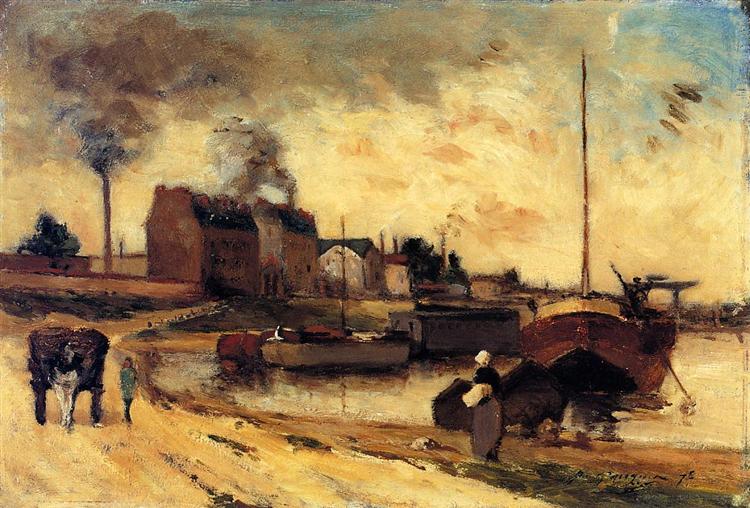Description
Paul Gauguin's *Factories at Cail and Quai de Grenelle* (1875) offers an instructive and evocative depiction of the industrial environment of the time, marked by the transition to a modern world. This painting, which falls within the realm of realism, reveals Gauguin's mastery in capturing urban life and his ability to combine architectural and natural elements in a balanced and dynamic composition.
From the first glance, the work presents itself as a vivid portrait of the urban landscape, where the Cail factories, iconic of industrialization, stand out. The composition shows a panoramic view that invites the viewer to explore both the environment and the interaction between the elements. The factories, with their characteristic smoking chimneys, rise above a river that meanders through the landscape, creating a synergy between human creation and the natural environment. This relationship is central to the work, where modernity is associated with both the industrial revolution and the surrounding nature.
Colour plays a central role in Gauguin’s visual narrative. An earthy palette, dominated by browns, yellows and greys, is prevalent, evoking the essence of industrial construction. It is interesting to note how these tones are balanced by softer hues in the sky and in the reflection of the water, creating an almost melancholic atmosphere, despite the obvious activity of the scene. The contrast between the harshness of the industrial structures and the softness of the natural surroundings suggests an underlying critique of the dehumanisation brought about by modernisation.
The characters are few in number in this work, which could be interpreted as a deliberate choice by Gauguin to focus attention on the landscape itself and to underline the enormity of the factories compared to the insignificance of the human being in this vast transformation. The absence of central figures reinforces the idea of an environment that advances without the active intervention of the individual, suggesting a social critique in which industrialization displaces the role of man in the creative process of the world.
Another fascinating aspect of this work lies in its historical context. Painted at a time when Paris was experiencing rapid industrial and urban development, *Factories at Cail and Quai de Grenelle* captures a significant moment in French history. Although Gauguin is best known for his later stay in Tahiti and his work in Symbolism, this early effort shows his ability to observe and understand the complexity of his contemporary environment.
In conclusion, *Fabrics de Cail et Quai de Grenelle* is not only an aesthetic representation of the industrial landscape, but also a meditation on the impact of modernity on humans and nature. The work invites a dialogue on progress, identity and the place of the individual in a rapidly changing world, thus ensuring Gauguin's legacy as a sensitive observer of his time. His ability to intertwine the real with a deep existential reflection makes him a precursor to later movements that explore the relationship between humans and their environment, both natural and built.
KUADROS ©, a famous painting on your wall.
Hand-made oil painting reproductions, with the quality of professional artists and the distinctive seal of KUADROS ©.
Painting reproduction service with satisfaction guarantee. If you are not completely satisfied with the replica of your painting, we will refund 100% of your money.

